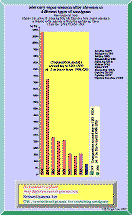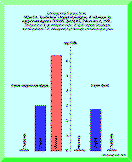![]()
On the Instability of Amalgams
- Increased mercury emission...
![]()
The symbiosis between the dental and industrial communities and their scientific journals
![]()
On the Instability of Amalgams...cont. -
Abstract
Conventional amalgams are regarded as less favorable because of their proneness to corrosion and mechanical weakness. An invention by a Canadian scientist in 1963 marked the introduction of the modern non-gamma-two amalgams said to overcome these drawbacks. Now some thirty years later it is obvious that they also exhibit a drastic reduction in stability. The emission of mercury vapor - see Figure 2 - is drastically increased and is combined with the formation of deposits on the surface after abrasion, see picture above. No scientific article has been accepted for publication on this striking and highly visual phenomenon of instability - just a few IADR Abstracts have been dealing with it.
These new amalgams were marketed for a long time in opposition to the composition-standard in force. When they became dominating on the market the standard was rewritten allowing the use of non-gamma-two amalgams that had already been sold for more than a decade. Standards for testing the stability - emissions of toxic substances - of amalgams are non-existing. One reason for the increased strength of modern amalgams could be that they contain bronze.
Copper amalgam is currently used in Russia, in Norway until 1994 and in Sweden in the 1980's and is regarded as the most unstable of allamalgams used. Their rate of corrosion is legendary, in rare cases giving teeth a greenish color from corrosion products. Statistics on the use of this material are lacking and scientific articles are few. It was predominantly used in children with extensive caries attacks. In an almost unknown letter from the Scandinavian Institute of Dental Materials, NIOM, the intake of metals from copper amalgam is estimated. It is concluded that the intake of mercury - in a worst case scenario - can be 315 times that from food, see Figure 1. Except Norway no other of the NIOM-countries or the NIOM board were informed. Copper amalgams have also been used in Germany. In the US copper amalgam has been used in an admixture with conventional amalgam.
Excretion-rates of mercury in subjects with a fair amount of amalgam fillings exceeds the WHO provisional limit of total intake by food.
Testing of all types of dental materials including composites, porcelains, cements and so on must take place prior to the introduction on the market. Dental materials - by far the most wide spread implant in the population - must be subjected to both stability tests revealing emitted substances and relevant biological testing.
To the Introduction
On Reality. Publisher and editor: Bo Walhjalt. ISSN 1650-9323.
© Bo Walhjalt and authors. | Comments on this page
Latest update 2002-12-05original url of this page: http://www.gbg.bonet.se/bwf/art/instab/abstract.html

